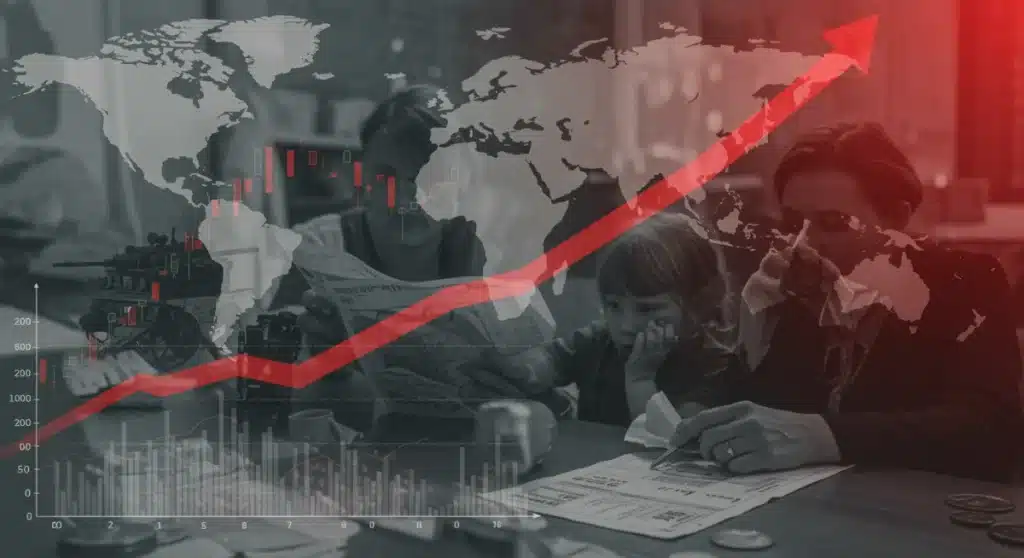2025 Inflation Forecast: Geopolitical Shifts & US Household Budgets

As of late 2024, significant economic analyses are pointing to a challenging fiscal year ahead. The 2025 Inflation Forecast indicates that geopolitical shifts are poised to impact US household budgets by an estimated 3.5%, a figure that demands immediate attention from policymakers and consumers alike. This developing situation suggests a direct connection between international instability and domestic financial strain, raising critical questions about economic resilience.
Understanding the 2025 Inflationary Pressures
The projected 3.5% inflation figure for 2025 is not an isolated prediction; it stems from a confluence of global and domestic factors. Economists are closely monitoring how various forces are converging to create this challenging economic outlook, with a particular focus on geopolitical developments.
Several key elements are contributing to these inflationary pressures, impacting everything from energy prices to consumer goods. The interconnectedness of the global economy means that disruptions in one region can quickly ripple across continents, affecting supply chains and commodity markets.
Key Drivers of Inflation
The primary drivers behind the anticipated 2025 inflation are multifaceted. These include ongoing supply chain vulnerabilities, heightened energy costs, and shifts in global trade policies. Each of these elements plays a crucial role in the overall economic landscape.
- Supply Chain Vulnerabilities: Persistent disruptions from past events, coupled with new geopolitical tensions, continue to strain global logistics. This leads to higher shipping costs and delays, which are ultimately passed on to consumers.
- Elevated Energy Prices: Global energy markets remain volatile, influenced by production cuts, geopolitical conflicts, and increasing demand. Higher fuel costs directly impact transportation and manufacturing, contributing significantly to inflation.
- Trade Policy Shifts: Changes in international trade agreements and tariffs can alter the cost of imported goods. Protectionist measures or new trade barriers can make foreign products more expensive, encouraging domestic price increases.
Geopolitical Shifts: A Primary Catalyst
The role of geopolitical shifts in shaping the 2025 Inflation Forecast cannot be overstated. From regional conflicts to international trade disputes, these events create uncertainty and directly influence economic stability. The current global landscape is exceptionally fluid, with several flashpoints that could escalate and further disrupt markets.
Recent analyses from institutions like the International Monetary Fund (IMF) and the World Bank consistently highlight geopolitical instability as a top risk to global economic growth and price stability. These shifts manifest in various ways, from direct impact on commodity markets to indirect effects on investor confidence and supply routes.
Regional Conflicts and Their Economic Fallout
Ongoing conflicts in critical regions, particularly in Eastern Europe and the Middle East, have far-reaching economic consequences. These conflicts disrupt the production and transport of essential goods, leading to price spikes and shortages.
- Energy Market Volatility: Conflicts in oil and gas producing regions directly affect global energy prices. Sanctions, threats to shipping lanes, and infrastructure damage can cause sudden and significant price increases for crude oil and natural gas.
- Food Security Concerns: Regions known for agricultural exports, when destabilized by conflict, can lead to global food shortages and price hikes. This disproportionately affects lower-income households, increasing food inflation.
- Supply Route Disruptions: Key maritime and land trade routes can become unsafe or inaccessible due to geopolitical tensions. This forces rerouting, increasing transit times and costs, impacting a wide range of goods.
Impact on US Household Budgets: The 3.5% Projection
The projected 3.5% impact on US household budgets represents a tangible reduction in purchasing power. This figure, derived from comprehensive economic modeling, indicates that the average American household will need to spend 3.5% more to maintain their current living standard. This is a crucial aspect of the 2025 Inflation Forecast.
This increase translates to higher costs for everyday necessities, from groceries and gasoline to housing and utilities. For many families, this means difficult choices and budget adjustments, potentially leading to reduced savings or increased debt.
Sector-Specific Price Increases
While the 3.5% is an average, certain sectors are expected to see more pronounced price increases. Understanding these specific areas can help households prepare for the upcoming economic climate.
Housing costs, energy expenditures, and food prices are typically among the most sensitive to inflationary pressures. These are also non-discretionary expenses, meaning households have limited flexibility to reduce spending in these areas.
According to a recent report by the Bureau of Economic Analysis (BEA), core inflation metrics are already showing upward trends in these critical sectors. The 3.5% projection for 2025 builds upon these existing trajectories, suggesting a sustained increase rather than a temporary spike.

Government and Central Bank Responses
In anticipation of the 2025 Inflation Forecast, governments and central banks, particularly the Federal Reserve, are closely monitoring economic indicators and considering various policy responses. The goal is to mitigate the impact of inflation without stifling economic growth.
Monetary policy tools, such as interest rate adjustments, are primary instruments used by central banks to manage inflation. Fiscal policies, including government spending and taxation, also play a significant role in influencing the overall economic environment.
Monetary Policy Adjustments
The Federal Reserve’s actions will be critical in shaping the economic trajectory for 2025. Their decisions on interest rates directly influence borrowing costs for consumers and businesses, affecting investment and spending.
- Interest Rate Hikes: To combat inflation, the Fed may continue or initiate interest rate increases. This makes borrowing more expensive, cooling demand and theoretically reducing price pressures.
- Quantitative Tightening: Reducing the money supply through the sale of government bonds is another tool. This aims to pull liquidity out of the financial system, further dampening inflationary pressures.
Fiscal Policy and Support Programs
Beyond monetary policy, governmental fiscal measures can provide targeted relief or stimulate specific sectors. These policies often involve direct interventions to support households or industries facing significant inflationary burdens.
For example, energy subsidies, tax breaks for essential goods, or direct financial aid programs could be implemented to offset some of the projected 3.5% increase in living costs. However, such measures also carry the risk of further stimulating demand if not carefully managed.
Long-Term Economic Outlook and Consumer Adaptation
The 2025 Inflation Forecast, specifically the 3.5% impact on US household budgets, prompts a broader discussion about long-term economic resilience and consumer adaptation strategies. While immediate concerns focus on managing the upcoming year, the underlying drivers suggest a need for sustained adjustments.
Households and businesses are already exploring ways to become more resilient to price fluctuations. This includes diversifying income streams, investing in energy-efficient solutions, and re-evaluating spending habits. The economic environment of 2025 may accelerate these adaptations.
Strategies for Households
For individual households, proactive financial planning will become even more critical. Understanding where the 3.5% increase is likely to hit hardest can inform budgeting decisions and help mitigate the impact.
Financial advisors are increasingly recommending a focus on emergency savings, debt reduction, and strategic investments. The goal is to build a financial buffer that can absorb unexpected cost increases without severe disruption to daily life.
Furthermore, exploring opportunities for increased household income, through part-time work or skill development, could become a more prevalent strategy. The ability to adapt quickly to changing economic conditions will be a key differentiator.
Global Trade and Supply Chain Resilience
The persistent vulnerability of global trade and supply chains remains a central theme in the 2025 Inflation Forecast. Geopolitical events expose the fragility of systems designed for efficiency over resilience. Building more robust and diversified supply networks is a critical long-term objective for both governments and multinational corporations.
Efforts to ‘onshore’ or ‘friendshore’ production are gaining traction, aiming to reduce reliance on distant or politically unstable regions. While these strategies can increase initial costs, they offer greater security against future disruptions and contribute to more stable pricing in the long run.
Investing in Resilient Infrastructure
Governments and private sectors are now prioritizing investments in infrastructure that can withstand global shocks. This includes modernizing ports, improving logistics networks, and developing alternative energy sources to reduce dependence on volatile fossil fuel markets.
- Diversification of Sourcing: Companies are actively seeking multiple suppliers from different geographical regions to minimize the impact of localized disruptions. This strategy enhances flexibility and reduces risk.
- Technological Integration: Advanced analytics and AI are being deployed to better predict and manage supply chain risks. Real-time data can help businesses respond more quickly to emerging threats, ensuring continuity.
- Strategic Reserves: Maintaining strategic reserves of critical goods, from energy to medical supplies, provides a buffer against sudden shortages caused by geopolitical events or natural disasters.
| Key Point | Brief Description |
|---|---|
| 2025 Inflation Projection | US household budgets projected to increase by 3.5% due to inflation. |
| Geopolitical Impact | Global conflicts and trade disputes are primary drivers of inflationary pressures. |
| Household Budget Strain | Higher costs for essentials like food, energy, and housing expected. |
| Policy Responses | Central banks and governments considering monetary and fiscal adjustments. |
Frequently Asked Questions About 2025 Inflation
The primary cause of the 2025 inflation forecast, particularly the 3.5% impact on US households, is largely attributed to ongoing geopolitical shifts. These shifts include regional conflicts, trade disputes, and their subsequent effects on global supply chains and commodity markets, especially energy and food.
A 3.5% inflation rate means average US households will need to spend 3.5% more to maintain their current living standards. This translates to increased costs for essential goods and services such as groceries, gasoline, utilities, and housing, potentially reducing disposable income and savings.
Central banks, including the Federal Reserve, are considering monetary policy adjustments. These typically involve raising interest rates to cool demand and potentially engaging in quantitative tightening to reduce the money supply. The goal is to bring inflation back to target levels without triggering a recession.
Sectors expected to be most impacted by the predicted inflation include energy, food, and housing. These are typically non-discretionary expenses for households, meaning price increases in these areas will have a more direct and significant effect on daily budgets and overall cost of living.
Households can prepare by focusing on financial planning, including building emergency savings, reducing debt, and reviewing budgets to identify areas for adjustment. Exploring opportunities for increased income or investing in energy-efficient home improvements can also help mitigate the impact of rising costs.
What This Means for the Future
The 2025 Inflation Forecast, with its projected 3.5% impact on US household budgets driven by geopolitical shifts, underscores a critical juncture for the global economy. This isn’t merely a statistic; it represents a tangible challenge to economic stability and individual financial well-being. Looking ahead, the interplay between international relations, commodity markets, and domestic policy will dictate the severity and duration of these inflationary pressures. Policymakers face the delicate task of balancing economic growth with price stability, while households must remain vigilant and adaptable. The coming months will be crucial in observing how these complex dynamics unfold and how effectively global and national actors respond to the evolving economic landscape.





